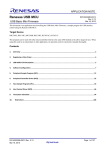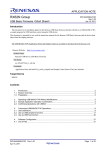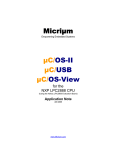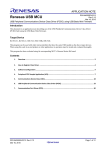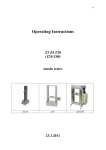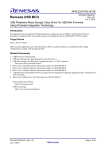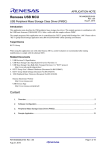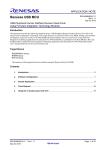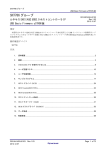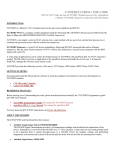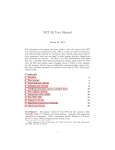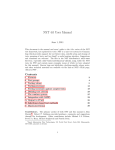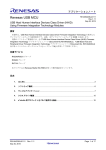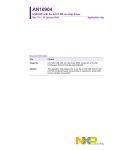Download USB Host Human Interface Device Class Driver (HHID)
Transcript
APPLICATION NOTE
Renesas USB MCU
R01AN0664EJ0213
Rev.2.13
Mar 16, 2015
USB Host Human Interface Device Class Driver (HHID) using Basic Mini Firmware
Introduction
This document is an application note describing use of the USB Host Human Interface Device Class Driver (HHID)
built using the USB Basic Mini Firmware of the Renesas USB MCU.
Target Device
RL78/G1C, R8C/3MK, R8C/34K
This program can be used with other microcontrollers that have the same USB module as the above target devices.
When using this code in an end product or other application, its operation must be tested and evaluated thoroughly.
This program has been evaluated using the corresponding MCU’s Renesas Starter Kit board.
Contents
1.
Overview ................................................................................................................................................... 2
2.
Register Class Driver .................................................................................................................................. 4
3.
Software Configuration ............................................................................................................................. 4
4.
Host HID Sample Application Program (APL) ............................................................................................. 8
5.
Human Interface Device Class (HID) ........................................................................................................ 21
6.
USB Host Human Interface Device Class Driver (HHID) ............................................................................ 22
7.
Limitations .............................................................................................................................................. 38
R01AN0664EJ0213 Rev.2.13
Mar 16, 2015
Page 1 of 39
Renesas USB MCU
1.
USB Host Human Interface Device Class Driver (HHID)
Overview
This application note describes the USB Host Human Interface Device Class Driver (HHID) and the sample application
using USB Basic Mini Firmware (refer to the Chapter 1.2).
1.1
Functions and Features
The USB Host Human Interface Device Class Driver (HHID) conforms to the USB Human Interface Device Class
specification (HID from now on and description). It and enables communication with a HID peripheral device.
This class driver is intended to be used in combination with the USB Basic Mini Firmware provided from Renesas
Electronics.
1.2
Related Documents
1.
2.
3.
Universal Serial Bus Revision 2.0 specification
USB Class Definitions for Human Interface Devices Version 1.1
HID Usage Tables Version 1.1
[http://www.usb.org/developers/docs/]
4. User's Manual: Hardware
5. USB Basic Mini Firmware Application Note (Document No.R01AN0326EJ)
Available from the Renesas Electronics Website
・ Renesas Electronics Website
[http://www.renesas.com/]
・ USB Devices Page
[http://www.renesas.com/prod/usb/]
1.3
Terms and Abbreviations
Terms and abbreviations used in this document are listed below.
API
APL
cstd
Data Transfer
HCD
HDCD
HEW
HHID
HID
HM
hstd
KBD
MGR
MSE
PP
RSK
Scheduler
Scheduler Macro
SW1/SW2/SW3
Task
USB
USB-BASIC-FW
:
:
:
:
:
:
:
:
:
:
:
:
:
:
:
:
:
:
:
:
:
:
Application Program Interface
Application program
Prefix for peripheral & host common function of USB-BASIC-F/W
Generic name of Control transfer, Bulk transfer and Interrupt transfer
Host control driver of USB-BASIC-F/W
Host device class driver (device driver and USB class driver)
High-performance Embedded Workshop
Host human interface device
Human interface device class
Hardware Manual
Prefix for host function of USB-BASIC-F/W
Keyboard device
Peripheral device state manager of HCD
Mouse device
Pre-processed definition
Renesas Starter Kit
Used to schedule functions, like a simplified OS
Used to call a scheduler function
User switches on RSK
Processing unit
Universal Serial Bus
USB-BASIC-F/W
(Peripheral & Host USB Basic Mini Firmware(USB low level) for Renesas USB
MCU)
R01AN0664EJ0213 Rev.2.13
Mar 16, 2015
Page 2 of 39
Renesas USB MCU
1.4
USB Host Human Interface Device Class Driver (HHID)
How to Read This Document
To run the demo, start by reading “USB Host Human Interface Device Class Driver (HHID) Installation Guide for USB
Basic Mini Firmware”.
This document is not intended for reading straight through. Use it first to gain acquaintance with the package, then to
look up information on functionality and interfaces as needed for your particular solution.
Chapter 4 explains how the default host HID demo application works. You will change this to create your own solution.
Understand how all code modules are divided into tasks, and that these tasks pass messages to one another. This is so
that functions (tasks) can execute in the order determined by a scheduler and not strictly in a predetermined order. This
way more important tasks can have priority. This plus the use of a function callback mechanism enables the USB code
to be non-blocking. The task mechanism is described in Chapter 1.2 above "USB Basic Mini Firmware Application
Note".
All HID tasks are listed in Chapter 3.4.
R01AN0664EJ0213 Rev.2.13
Mar 16, 2015
Page 3 of 39
Renesas USB MCU
2.
USB Host Human Interface Device Class Driver (HHID)
Register Class Driver
A class driver must be registered with the USB-BASIC-F/W. Please consult function usb_hapl_registration() in
r_usb_hhid_apl.on how to register a class driver with USB-BASIC-F/W. For details, please refer to USB Basic Mini
Firmware application note.
3.
Software Configuration
3.1
Module Configuration
The HHID comprises the HID class driver and the device drivers for mouse and keyboard.
Figure 3.1 shows the structure of the HHID software modules. Table 3-1 lists the modules and an overview of each.
User application (APL)
RSK driver
HHID
LCD output driver
USB Host class driver
LED output driver
USB-BASIC-F/W
Manager (MGR)
Key input driver
USB Host Control Driver (HCD)
LCD/LED/KEY (H/W)
USB Host controller (H/W)
Figure 3.1 Module Structure
Table 3-1 Module Function Descriptions
Module Name
APL
HHID
USB-BASIC-F/W
Description
User application program.
Board (RSK) switches initiate communication with attached HID
devices and control suspend/resume.
The LCD displays the information received from the HID device.
The registered device class driver checks operation of the connected
device. The USB-BASIC-F/W checks whether the connected device
enables for HHID. The following data transfers are requested of
USB-BASIC-F/W by the APL.
1) Control of connected device by HID requests
2) Data transfer with connected device
Transfer results are notified to APL by a callback function.
USB Basic Mini Firmware ( Host Hardware Control & Device state
Management)
R01AN0664EJ0213 Rev.2.13
Mar 16, 2015
Notes
Created
by the
customer.
Page 4 of 39
Renesas USB MCU
3.2
USB Host Human Interface Device Class Driver (HHID)
Overview of Application Program Functions
The main functions of the host demo application:
1. Data is received from the connected USB peripheral device and is displayed on the LCD.
a) When a USB mouse is connected (Mouse mode), the displacement values of the X and Y axes are shown on
the LCD. An LED is toggled by pressing the mouse buttons.
b) When a USB keyboard is connected (Keyboard mode), show one character of the key input data from the USB
keyboard report. Moreover, the NumLock LED is turned on when the device is in the configured state and the
NumLock LED is turned off when the device is in the suspended state.
2. Suspends/Resume of USB device operations.
a) The USB device is suspended and resumed alternately when SW3 on the RSK is pressed.
b) Resume is executed when a remote wakeup signal is received from a USB device.
Switch input operation is described in Table 3-2.
Table 3-2 User switch input operation
Switch Function
Data transfer start
State change
Description
Start ongoing requests for report reception.
Change the following USB state.
In data reception wait state (resumed), go to Suspend
state.
In Suspend state, go to data reception wait state
(Resume).
R01AN0664EJ0213 Rev.2.13
Mar 16, 2015
Switch Number
SW2
SW3
Page 5 of 39
Renesas USB MCU
3.3
3.3.1
USB Host Human Interface Device Class Driver (HHID)
File Configuration List
Folder Structure
The folder structure of the files supplied with the device class is shown below.
The source codes dependent on each MCU and evaluation board are stored in each hardware resource folder
(\devicename\src\HwResource).
[RL78/G1C, R8C]
+(Integrated development environment) [ CS+, HEW, IAR Embedded Workbench, e2 studio ]
+(MCU name)
Project File
+ HOST
Build result
+ src
+――― HIDFW [Human Interface Device Class driver ] See Table 3-3
|
+――― inc
Common header file of HID driver
|
+――― src
HID driver
+―――SmplMain [ Sample Application ]
|
+――― APL
Report display application
+―――USBSTDFW [Common USB code that is used by all USB firmware ]
|
+――― inc
Common header file of USB driver
|
+――― src
USB driver
+――― HwResource [Hardware access layer; to initialize the MCU ]
+――― inc
Common header file of hardware resource
+―――src
Hardware resource
R01AN0664EJ0213 Rev.2.13
Mar 16, 2015
Page 6 of 39
Renesas USB MCU
3.3.2
USB Host Human Interface Device Class Driver (HHID)
File Structure
Table 3-3 shows the file structure provided in the HHID.
Table 3-3 File Structure
Folder
HIDFW/inc
HIDFW/inc
HIDFW/inc
HIDFW/src
HIDFW/src
SmplMain
SmplMain/APL
3.4
3.4.1
File Name
r_usb_class_usrcfg.h
r_usb_hhid_define.h
r_usb_hhid_api.h
r_usb_hhid_api.c
r_usb_hhid_driver.c
main.c
r_usb_hhid_apl.c
Description
USB host HID user definition
HHID type definitions and macro definitions
HHID prototype, external reference
HHID API functions
HHID driver functions
Main loop function
Sample application program
Notes
System Resources
System Resource Definitions
Table 3-4 lists the Task ID and the task priority definitions used to register HHID in the scheduler. These are defined in
the r_usb_ckernelid.h header file.
See 1.4 for why tasks are used.
Table 3-4 List of Scheduler Registration IDs
Scheduler registration task
USB_HHID_TSK
USB_HCD_TSK
USB_MGR_TSK
Mailbox ID / Default receive task
USB_HHID_MBX
/ USB_HHID_TSK
USB_HCD_MBX
/ USB_HCD_TSK
USB_MGR_MBX
/ USB_MGR_TSK
R01AN0664EJ0213 Rev.2.13
Mar 16, 2015
Description
HHID (R_usb_hhid_task)
Task ID: USB_HHID_TSK
Task priority: 2
HCD (R_usb_hstd_HcdTask)
Task ID: USB_HCD_TSK
Task priority: 0
MGR (R_usb_hstd_MgrTask)
Task ID: USB_MGR_TSK
Task priority: 1
Message description
HHID -> HHID / APL -> HHID mailbox ID
Notes
Notes
HCD task mailbox ID
MGR task mailbox ID
Page 7 of 39
Renesas USB MCU
4.
USB Host Human Interface Device Class Driver (HHID)
Host HID Sample Application Program (APL)
The host demo application performs display of received USB data when connected to a HID peripheral device. The
HHID application complies with the USB Human Interface Device Class specifications. See Chapter 1.2 item 2 and 3.
4.1
Operating Environment
The Figure 4.1 and Figure 4.2 show a sample operating environment for the software.
HID host
USB communication
RSK Board
LCD
A
Peripheral HID device
Key data
“A“
USB
PORT
USB
USB
PORT
keyboard
NumLock LED
On / Off
HHID
+
USB-BASIC-F/W
Figure 4.1 Example Operating Environment with a connected keyboard.
USB communication
HID host
Peripheral HID device
X/Y motion data
“X: 10, Y: -20”
RSK Board
LCD
10
-20
LED
0 1 2
USB
PORT
Button data
“Right click”
USB
PORT
USB mouse
LED0: left click
LED1: right click
LED2: wheel click
HHID
+
USB-BASIC-F/W
Figure 4.2 Example Operating Environment with a connected mouse.
R01AN0664EJ0213 Rev.2.13
Mar 16, 2015
Page 8 of 39
Renesas USB MCU
4.1.1
USB Host Human Interface Device Class Driver (HHID)
Report reception
When the USB_HHID_GET_REPORT_PIPE0 macro in the r_usb_class_usrcfg.h file is made active, report reception is
made possible by the control transfer GET_REPORT request.
4.2
Description of Application Program Processing
The following lists application operation with respect to Figure 4.4, on page 12.
・ HID peripheral device attachment. (Corresponding to Process No.0-1)
Whether a connected device is a mouse or a keyboard is automaticallydetermined. The distinction between the two
is done using bInterfaceProtocol of the Configuration descriptor (Refer to Table 4-1). Ther application program
does not analyze the report descriptor.
Data Communication
Start (Process 1-1):
Communication with a USB device is started when SW2 is pressed (Refer to Table 3-2).
Complete (Process 2-1):
Communication with a USB device is completed when the callback function is generated from the HHID.
Operation
During Data Communication (Process 3-1):
Analyzes reports received from the peripheral device and displays them on LCD (Refer to Table 4-2).
During Suspend state (Process 2-2):
Data communication is terminated and the USB device is suspended when SW3 is pressed (Refer to Table
3-2).
During Resume (Process 4-1):
USB device is resumed and data communication restarts when SW3 is pressed (Refer to Table 3-2).
Table 4-1 Mode Switching
bInterfaceProtocol
0x01
0x02
else
Mode
Keyboard Mode
Mouse Mode
not possible to operate
Description
Indicates that a keyboard device is connected
Indicates that a mouse device is connected
Not recognized as an operable HID device connection.
Table 4-2 Operation During Data Communication
Mode
Keyboard Mode
Mouse Mode
4.3
Description
Display of received key data (key code to ASCII conversion)
Display of received coordinate data
Endpoint Specifications
The endpoints use by the HHID is shown in Table 4-3.
Table 4-3 Endpoint Specifications
Endpoint Number
Pipe Number
Transfer Method
Description
0
0
Control In/Out
Standard request, class request
Follows received
6
Interrupt In
Data transfer from device to host
Descriptor from
attached device
The Endpoint numbers are determined by the device’s endpoint descriptors.
R01AN0664EJ0213 Rev.2.13
Mar 16, 2015
Page 9 of 39
Renesas USB MCU
4.4
4.4.1
USB Host Human Interface Device Class Driver (HHID)
Allowed HID Peripherals
Supported Features
Full-Speed/Low-Speed keyboard s .
Three button mouse (FullSpeed/LowSpeed).
4.4.2
Non-supported Features
Devices with built-in HUB, or composite devices.
4.5
List of APL Functions
Table 4-4 lists the functions of the sample application.
Table 4-4 List of Functions of Sample Application
Function Name
main
usb_hsmpl_main_init
usb_hhid_MainTask
usb_hapl_registration
usb_hhid_class_check
usb_hsmpl_device_state
usb_hhid_smpl_data_trans_result
usb_hhid_smpl_mse_data
usb_hhid_smpl_val_to_str
usb_hhid_smpl_kbd_data
usb_hhid_smp_status_set
usb_hhid_smpl_get_hid_descriptor
usb_hhid_smpl_get_report_descriptor
usb_hhid_smpl_get_physical_descriptor
usb_hhid_smpl_kbd_led_ctl
usb_hhid_smpl_set_report
usb_hhid_smpl_get_report
usb_hhid_smpl_set_idle
usb_hhid_smpl_get_idle
usb_hhid_smpl_set_protocol
usb_hhid_smpl_get_protocol
usb_hsmpl_class_result
usb_hhid_smpl_get_report_result
usb_hhid_smpl_kbd_led_ctl_result
R01AN0664EJ0213 Rev.2.13
Mar 16, 2015
Description
Main loop processing.
System initialization.
Task start up processing for Host USB.
Sample application main processing.
HHID driver registration.
Check that connected device is a HID.
Application status change callback function.
Data transfer complete processing.
Mouse data reception processing.
1-byte numeric data string conversion processing.
Keyboard data reception processing.
Sample application mode setting processing.
HID descriptor processing.(not used).
Report descriptor getting processing.(not used).
Physical descriptor getting processing.(not used).
Keyboard LED ON/OFF control.
SET REPORT request processing.(not used).
GET REPORT request processing.(not used).
SET IDLE request processing.(not used).
GET IDLE request processing.(not used).
SET PROTOCOL request processing.(not used).
GET PROTOCOL request processing.(not used).
HID class request callback function.
GET REPORT request callback function.
SET REPORT request callback function.
Page 10 of 39
Renesas USB MCU
4.6
USB Host Human Interface Device Class Driver (HHID)
Host Application Task Sequence
The following explains how the LCD display is updated, and state transition controls.
4.6.1
Displayed Information
The application displays the USB device connection state and the content of reports received on the LCD.
When a keyboard is connected, the character of the last key pressed on the keyboard is displayed.
When a mouse is connected, the X/Y motion data is displayed. Values between -128 to 127 are displayed (right
justified).
If the content of a received report is NULL (no key press on the keyboard or no XY motion from the mouse), the
display on the LCD is not updated. The LCD display state transition is shown in Figure 4.3.
(1) Initial display at power-on
DETACH
USB mouse
USB keyboard
(2) USB mouse attachment
(3) USB keyboard attachment
USB MSE
ATTACH
USB KBD
ATTACH
Receive report
(4) USB mouse receive report display
-1
Receive report
(5) USB keyboard receive report display
2
A
(6) Detachment display
USB
DETACH
Figure 4.3 The Transition of the Display State on the LCD
R01AN0664EJ0213 Rev.2.13
Mar 16, 2015
Page 11 of 39
Renesas USB MCU
4.6.2
USB Host Human Interface Device Class Driver (HHID)
State Transitions
Figure 4.4 shows the application state transition. Each block is a program “state”.
[Process No. 0-0]
[Process No. 7-0]
Power-on
DETACH
USB
DETACH
DETACH
0. Initialization
7. Detach
(USB_HHID_APL_CLOSE)
USB MSE
ATTACH
Device
Attach
[Process 0-1]
USB KBD
ATTACH
USB keyboard or USB mouse attachment
(USB_STS_CONFIGURED)
1. Open (configured)
6. Control transfer complete
[Process 1-1]
Press the data
transfer start switch
[Process 6-1]
Data transmission started by RSK SW2
press (Report receive request)
usb_hhid_MainTask()
usb_hhid_MainTask()
[Process 2-3]
Control transfer complete
Foe Ex)
usb_hhid_smpl_get_report_result ()
2. Receive wait
[Process 2-2]
[Process 1-1]
Press the state
change switch
Receive report
usb_hhid_smpl_data_trans_result()
Data transmission terminated and peripheral
device suspended . (RSK SW3 pressed.)
usb_hhid_MainTask()
3. Receive
4. Suspend
[Process 4-1]
-1
2
[Process3-1]
Press the state
change switch
Received data is displayed
on the LCD and Report
receive request
A
usb_hhid_MainTask()
5. Resume
[Process 5-1]
Report receive request
explanatory note
State
Peripheral device resume by RSK SW3
press or remote wakeup
usb_hhid_smp_status_set
(USB_HHID_APL_OFFSET_RESUME)
User
oparation
LCD
display
[Process x-x]
usb_hhid_MainTask()
process number
Figure 4.4 Application State Transitions
R01AN0664EJ0213 Rev.2.13
Mar 16, 2015
Page 12 of 39
Renesas USB MCU
4.7
USB Host Human Interface Device Class Driver (HHID)
SW Processing Flow Graphs
The following shows the application task processing flow overview.
usb_hhid_
AppTask
Mode setting
Open state
Data transfer
start switch OFF
Switch data
Data transfer
start switch ON
Receive wait
state
Data transfer start
switch OFF
Switch data
State change
switch ON
USB data transfer
forcible termination
Report length
acquisitionR_usb_hhid_
GetReportLength()
usb_hhid_
TransferEnd()
Change mode setting
(Receive wait state)
Change mode setting
(Suspend state)
Initial LCD message
Change device state
(suspend)
USB data transfer
(receive report)
R_usb_hhid_
PipeTransferExample()
Receive state
Display receive data
(report) display
usb_hhid_MseData()
or
usb_hhid_KbdData()
Change mode setting
(Receive wait state)
USB data transfer
(receive report)
R_usb_hhid_
PipeTransferExample()
R_usb_hstd_
ChangeDeviceState()
Return
Else
Mode setting
Control transfer complete
state
Suspend state
State change
switch OFF
Change mode setting
(Receive wait state)
Resume state
Change mode setting
(Receive wait state)
Switch data
State change
switch ON
Change device state
(resume)
R_usb_hstd_
ChangeDeviceState()
USB data transfer
(receive
report)R_usb_hhid_
PipeTransferExample()
Return
Figure 4.5 Application Task Processing Flow Overview
R01AN0664EJ0213 Rev.2.13
Mar 16, 2015
Page 13 of 39
Renesas USB MCU
4.8
USB Host Human Interface Device Class Driver (HHID)
Sequences charts APL-HHID-HCD
The operation sequence of the sample application program is described below.
4.8.1
Startup to HID Device Attachment
The sequence from sample application program startup through completion of enumeration, application task startup,
and completion of pipe control register setting is illustrated in Figure 4.6
HW Reset processing
HHID
USB-BASIC-F/W
Explanatory
MCU Initialization
Task Start (Receive Massage)
Send Message
Start main task
Main task
Task Stop (Return to mainloop)
Processing function
System call function (Send Message)
APL
Processing (Program executing)
Start USB-BASIC-F/W
R_usb_hstd_HcdOpen()
Return
Register HHID class driver
R_usb_hstd_DriverRegistration()
Start HHID task
R_usb_hhid_DriverStart()
Return
Return
Start task scheduling (main loop)
HID device attach
Application task
usb_hhid_MainTask
USB-BASIC-F/W
R_usb_hstd_HcdTask
R_usb_hstd_MgrTask
HHID task
R_usb_hhid_task
usb_hhid_class_check()
R_usb_hhid_ClassCheck()
Enumeration
(Get Device Descriptor,
Set Address,
Get Configuration Descriptor)
Return
Enumeration processing
usb_hhid_enumeration_sequence()
Get StringDescriptor,etc
Check OK
R_usb_hstd_ReturnEnuMGR()
usb_hsmpl_device_state()
operates by the context of
USB-BASIC-FW.
USB_STS_CONFIGURED
Configuard call-back
usb_hsmpl_device_state()
Enumeration
(SET_CONFIGURATION)
Pipe registration / Pipe configuration
R_usb_hhid_SetPipeRegistration()
Set three pipes
Int IN
Return
usb_shhid_apl_function =
USB_HHID_APL_INIT
Return
Continue with data communication sequence.
Figure 4.6 Startup to HID Device Attachment Sequence
R01AN0664EJ0213 Rev.2.13
Mar 16, 2015
Page 14 of 39
Renesas USB MCU
4.8.2
USB Host Human Interface Device Class Driver (HHID)
Data Communication
Figure 4.7 and Figure 4.8 show the data transfer sequence that is connected by the keyboard device. The case where the
report is received by the interrupt transfer is Figure 4.7. The case where the report is received by the control transfer is
Figure 4.8.
APL
HHID
USB-BASIC-F/W
Continue from startup to HID device attachment sequence.
LCD display as
“KBD ATTACH”
Judgment of connected device.
R_usb_hhid_get_hid_protocol()
usb_shhid_apl_function =
USB_HHID_APL_INIT
Class request SetReport
R_usb_hhid_class_request()
usb_shhid_apl_function =
USB_HHID_APL_KBD_OPEN
USB_HID_SET_REPORT
usb_shhid_apl_function =
USB_HHID_APL_KBD_OPEN
USB_HID_SET_REPORT
R_usb_hstd_TransferStart()
Class request SetProtocol
R_usb_hhid_class_request()
usb_shhid_apl_function =
USB_HHID_APL_KBD_RX_WAIT
USB_HID_SET_PROTOCOL
SW2
USB_HID_SET_REPORT
R_usb_hstd_TransferStart()
Data transmit request (receive report)
R_usb_hhid_PipeTransferExample()
USB_HHID_TCMD_DATA_TRANS
usb_shhid_apl_function =
USB_HHID_APL_KBD_RX_WAIT
USB_DATA_OK / USB_DATA_READING /
USB_DATA_SHT
Command notification
usb_hhid_smpl_data_trans_result()
Interrupt-IN transfer
R_usb_hstd_TransferStart()
transmit end call-back
usb_hhid_InTransferResult()
Interrupt IN transfer
Transfer end
usb_shhid_apl_function =
USB_HHID_APL_KBD_RX
usb_shhid_apl_function =
USB_HHID_APL_KBD_RX
LCD display of value acquired
from input report
Data transmit request (receive report)
R_usb_hhid_PipeTransferExample()
SET_REPORT
Command notification
usb_hhid_smpl_kbd_led_ctl_result()
SET_PROTOCOL
Command notification
usb_cstd_DummyFunction()
transmit end call-back
Control transfer
Transfer end
transmit end call-back
Control transfer
Transfer end
Continue with data communication sequence.
Figure 4.7 Interrupt-IN Communication Sequence by KBD
R01AN0664EJ0213 Rev.2.13
Mar 16, 2015
Page 15 of 39
Renesas USB MCU
USB Host Human Interface Device Class Driver (HHID)
APL
HHID
USB-BASIC-F/W
Continue from startup to HID device attachment sequence.
usb_shhid_apl_function =
USB_HHID_APL_INIT
LCD display as
“KBD ATTACH”
Judgment of connected device.
R_usb_hhid_get_hid_protocol()
Class request SetReport
R_usb_hhid_class_request()
usb_shhid_apl_function =
USB_HHID_APL_KBD_OPEN
USB_HID_SET_REPORT
usb_shhid_apl_function =
USB_HHID_APL_KBD_OPEN
SW2
USB_HID_SET_REPORT
R_usb_hstd_TransferStart()
Class request SetProtocol
R_usb_hhid_class_request()
usb_shhid_apl_function =
USB_HHID_APL_KBD_RX_WAIT
USB_HID_SET_PROTOCOL
USB_HID_SET_REPORT
R_usb_hstd_TransferStart()
Data transmit request (receive report)
R_usb_hhid_class_request()
USB_HID_GET_REPORT
usb_shhid_apl_function =
USB_HHID_APL_KBD_RX_WAIT
USB_HID_GET_REPORT
R_usb_hstd_TransferStart()
transmit end call-back
Control transfer
Transfer end
SET_REPORT
Command notification
usb_hhid_smpl_kbd_led_ctl_result()
transmit end call-back
Control transfer
Transfer end
SET_REPORT
Command notification
usb_hhid_smpl_kbd_led_ctl_result()
transmit end call-back
Control transfer
Transfer end
usb_hhid_smpl_get_report_result()
usb_shhid_apl_function =
USB_HHID_APL_KBD_RX
usb_shhid_apl_function =
USB_HHID_APL_KBD_RX
LCD display of value acquired
from input report
Data transmit request (receive report)
R_usb_hhid_class_request()
Continue with data communication sequence.
Figure 4.8 Control transfer Communication Sequence by KBD
R01AN0664EJ0213 Rev.2.13
Mar 16, 2015
Page 16 of 39
Renesas USB MCU
USB Host Human Interface Device Class Driver (HHID)
Figure 4.9 and Figure 4.10 show the data transfer sequence that is connected by the mouse device. The case where the
report is received by the interrupt transfer is Figure 4.9. The case where the report is received by the control transfer is
Figure 4.10.
APL
HHID
USB-BASIC-F/W
Continue from startup to HID device attachment sequence.
usb_shhid_apl_function =
USB_HHID_APL_INIT
LCD display as
“MSE ATTACH”
Judgment of connected device.
R_usb_hhid_get_hid_protocol()
usb_shhid_apl_function =
USB_HHID_APL_MSE_OPEN
usb_shhid_apl_function =
USB_HHID_APL_MSE_OPEN
Data transmit request (receive report)
R_usb_hhid_PipeTransferExample()
SW2
usb_shhid_apl_function =
USB_HHID_APL_MSE_RX_WAIT
USB_HHID_TCMD_DATA_TRANS
usb_shhid_apl_function =
USB_HHID_APL_MSE_RX_WAIT
USB_DATA_OK / USB_DATA_READING /
USB_DATA_SHT
Command notification
usb_hhid_smpl_data_trans_result()
Interrupt-IN transfer
R_usb_hstd_TransferStart()
transmit end call-back
usb_hhid_InTransferResult()
Interrupt IN transfer
Transfer end
usb_shhid_apl_function =
USB_HHID_APL_MSE_RX
usb_shhid_apl_function =
USB_HHID_APL_MSE_RX
LCD display of value acquired
from input report
Data transmit request (receive report)
R_usb_hhid_PipeTransferExample()
Continue with data communication sequence.
Figure 4.9 Interrupt-IN Communication Sequence by MSE
R01AN0664EJ0213 Rev.2.13
Mar 16, 2015
Page 17 of 39
Renesas USB MCU
USB Host Human Interface Device Class Driver (HHID)
APL
HHID
USB-BASIC-F/W
Continue from startup to HID device attachment sequence.
usb_shhid_apl_function =
USB_HHID_APL_INIT
LCD display as
“MSE ATTACH”
Judgment of connected device.
R_usb_hhid_get_hid_protocol()
usb_shhid_apl_function =
USB_HHID_APL_MSE_OPEN
usb_shhid_apl_function =
USB_HHID_APL_MSE_OPEN
SW2
usb_shhid_apl_function =
USB_HHID_APL_MSE_RX_WAIT
Data transmit request (receive report)
R_usb_hhid_class_request()
usb_shhid_apl_function =
USB_HHID_APL_MSE_RX_WAIT
USB_HID_GET_REPORT
USB_HID_GET_REPORT
R_usb_hstd_TransferStart()
Control transfer
Transfer end
transmit end call-back
usb_hhid_smpl_get_report_result()
usb_shhid_apl_function =
USB_HHID_APL_MSE_RX
usb_shhid_apl_function =
USB_HHID_APL_MSE_RX
LCD display of value acquired
from input report
Data transmit request (receive report)
R_usb_hhid_class_request()
Continue with data communication sequence.
Figure 4.10 Control transfer Communication Sequence by MSE
4.8.3
HID Device Detach
The sequence when the HID device is detached is illustrated in Figure 4.11.
APL
HCDC
USB-BASIC-F/W
Continue from startup to HID device attachment sequence.
usb_hsmpl_device_state()
operates by the context of
USB-BASIC-FW.
Deta
ch d e
tecte
d
(*driver->statediagram)
usb_hsmpl_device_state()
R_usb_hhid_DriverStop()
Initialized pipe information table
usb_shhid_apl_function =
USB_HHID_APL_CLOSE
usb_shhid_apl_function =
USB_HHID_APL_CLOSE
Return
Continue with data communication sequence.
Figure 4.11 Device Detach Sequence
R01AN0664EJ0213 Rev.2.13
Mar 16, 2015
Page 18 of 39
Renesas USB MCU
4.8.4
USB Host Human Interface Device Class Driver (HHID)
HID Device Suspended, Resumed
Figure 4.12 shows the suspend sequence. Figure 4.13 shows the resume sequence.
.
APL
HHID
USB-BASIC-F/W
Continue from startup to HID device attachment sequence.
usb_shhid_apl_function =
USB_HHID_APL_KBD_RX_WAIT
USB_HHID_APL_MSE_RX_WAIT
Data transfer termination
R_usb_hhid_TransferEnd()
SW3
R_usb_hstd_TransferEnd()
Change device state request (suspended)
R_usb_hhid_ChangeDeviceState()
usb_shhid_apl_function =
USB_HHID_APL_KBD_SUSPEND
USB_HHID_APL_MSE_SUSPEND
USB_DATA_STOP
Command notification
usb_hhid_smpl_data_trans_result()
usb_hsmpl_device_state()
operates by the context of
USB-BASIC-FW.
R_usb_hstd_MgrChangeDeviceState()
transmit end call-back
usb_hhid_InTransferResult()
Interrupt IN transfer
Termination end
(*driver->statediagram)
usb_hsmpl_device_state()
Return
Continue with data communication sequence.
Figure 4.12 HID Device Suspend Sequence
R01AN0664EJ0213 Rev.2.13
Mar 16, 2015
Page 19 of 39
Renesas USB MCU
USB Host Human Interface Device Class Driver (HHID)
APL
HHID
USB-BASIC-F/W
Continue from startup to HID device attachment sequence.
usb_shhid_apl_function =
USB_HHID_APL_KBD_SUSPEND
USB_HHID_APL_MSE_SUSPEND
Change device state request (suspended)
R_usb_hhid_ChangeDeviceState()
SW3
usb_hsmpl_device_state()
operates by the context of
USB-BASIC-FW.
R_usb_hstd_MgrChangeDeviceState()
(*driver->statediagram)
usb_hsmpl_device_state()
usb_shhid_apl_function =
USB_HHID_APL_KBD_RESUME
USB_HHID_APL_MSE_RESUME
usb_shhid_apl_function =
USB_HHID_APL_KBD_RESUME
USB_HHID_APL_MSE_RESUME
Return
Data transmit request (receive report)
R_usb_hhid_PipeTransferExample()
usb_shhid_apl_function =
USB_HHID_APL_KBD_RX_WAIT
USB_HHID_APL_MSE_RX_WAIT
Continue with data communication sequence.
Figure 4.13 HID Device Resume Sequence
R01AN0664EJ0213 Rev.2.13
Mar 16, 2015
Page 20 of 39
Renesas USB MCU
5.
USB Host Human Interface Device Class Driver (HHID)
Human Interface Device Class (HID)
This software conforms to the Human Interface Device Class specification, as specified in the document listed in
Chapter 1.2. The HID class consists primarily of devices that are used by humans to control the operation of computer
input devices. Typical examples of HID class devices include:
Keyboards and pointing devices - for example: standard mouse devices, trackballs, and joysticks.
Front-panel controls - for example: knobs, switches, buttons, and sliders.
Controls that might be found on devices such as telephones, VCR remote controls, games or simulation devices for example: data gloves, throttles, steering wheels, and rudder pedals.
5.1
Basic Functions
The main functions are as follows.
1.
2.
3.
4.
Verify that connected devices are of type HID.
Inquire about the capabilities and state of a device.
Set the state of output and feature items.
Contro the transfer of data from the HID peripheral device.
5.2
HID Class Requests (Host to Device)
The software supports the following HID class requests.
Table 5-1 HID Requests
Request
Code
Description
Support
Get_Report
0x01
Receives a report from the HID device
Yes
Set_Report
0x09
Sends a report to the HID device
Yes
Get_Idle
0x02
Receives a duration (time) from the HID device
No
Set_Idle
0x0A
Sends a duration (time) to the HID device
No
Get_Protocol
0x03
Reads a protocol from the HID device
No
Set_Protocol
0x0B
Sends a protocol to the HID device
No
Get_Report_Descriptor
Standard Transmit a report descriptor
Yes
Get_Hid_Descriptor
Standard Transmit a HID descriptor
Yes
For details concerning the Requests, refer to Chapter 7 in “USB Device Class Definitions for Human Interface Devices”,
Revision 1.1
R01AN0664EJ0213 Rev.2.13
Mar 16, 2015
Page 21 of 39
Renesas USB MCU
6.
USB Host Human Interface Device Class Driver (HHID)
USB Host Human Interface Device Class Driver (HHID)
6.1
Basic Functions
This software conforms to the Human Interface Device class specification. See Chapter 1.2 item 2 and 3.
The main functions of HHID are to:
1.
Send class requests to the HID peripheral
2.
Transfer data from the HID peripheral
6.2
HHID Task Description
This task receives messages in mailbox USB_HHID_MBX and performs processing according to the type of message.
Table 6-1 shows processing according to message type.
Table 6-1 Processing according to Received HHID Message Type
Message
USB_HHID_TCMD_OPEN
Processing
Gets the string descriptor
and sets the pipe
according the
enumeration sequence.
USB_HHID_TCMD_DATA_TRANS
Start Interrupt-IN transfer.
Notifies the application
when the data transfer is
completed.
The HID class request is
issued according to the
demand of the application
program shown by the
argument. Notifies the
application when the
control transfer is
completed.
USB_HHID_TCMD_CLASS_REQ
6.3
Message Source
R_usb_hhid_ClassCheck().
USB-BASIC-F/W and HHID check
the connected device via this
callback function during the
enumeration.
R_usb_hhid_PipeTransferExample().
When Interrupt-IN transfer is
completed this API function is
executed.
R_usb_hhid_class_request().
This API function is called from the
sample function which issues the
class request.
Target Peripheral List (TPL)
A host class driver is not required to support operation of all USB peripherals of the class. It is up to the manufacturer
of the host to determine what peripherals to support and provide a list of those peripherals. This is called the “Target
Peripheral List (TPL)”.
TPL is composed of an array of supported VID(s) and PID(s). To not check VID (/PID), specify USB_NOVENDOR
(/USB_NOPRODUCT). Refer to the usb_gapl_devicetpl[] array in the r_usb_hhid_driver.c file for the determination
of TPL.
R01AN0664EJ0213 Rev.2.13
Mar 16, 2015
Page 22 of 39
Renesas USB MCU
6.4
6.4.1
USB Host Human Interface Device Class Driver (HHID)
Structures
HHID Class API Function Structure
Table 6-2 describes the HID class request parameter structure.
Table 6-2 USB_HHID_CLASS_REQUEST_PARM_t Structure
Type
usb_addr_t
uint8_t
void*
usb_leng_t
uint16_t
uint8_t
uint8_t*
usb_cb_t
6.4.2
Member
devadr
bRequestCode
tranadr
tranlen
duration
set_protocol
get_protocol
complete
Description
Device address.
Class request code. Refer to the Table 6-3
Transfer data buffer.
Transfer size.
Response interval time rate to Interrupt transfer (4ms units).
Protocol value (Boot Protocol(=0)/Report Protocol(=1)).
Protocol value stored address.
Class request processing end call-back function.
HHID Class Request Code
Table 6-3 describes the code of the HID class requests.
Table 6-3 HHID Class Request code
Request Type
Get_Descriptor(HID)
Get_Descriptor(Report)
Get_Descriptor(Physical)
Set_Report
Get_Report
Set_Idle
Get_Idle
Set_Protocol
Get_Protocol
R01AN0664EJ0213 Rev.2.13
Mar 16, 2015
Definition Value
USB_HID_GET_HID_DESCRIPTOR
USB_HID_GET_REPORT_DESCRIPTOR
USB_HID_GET_PHYSICAL_DESCRIPTOR
USB_HID_SET_REPORT
USB_HID_GET_REPORT
USB_HID_SET_IDLE
USB_HID_GET_IDLE
USB_HID_SET_PROTOCOL
USB_HID_GET_PROTOCOL
Support
Yes
Yes
Yes
Yes
Yes
No
No
No
No
Page 23 of 39
Renesas USB MCU
6.4.3
USB Host Human Interface Device Class Driver (HHID)
HID-Report Format
(1). Receive Report Format
Table 6-4 shows the receive report format used for notifications from the HID device.
Reports are received in Interrupt-IN transfers or class request GetReport.
Table 6-4 Receive report format
Offset / Application
Data length
0 (Top Byte)
Keyboard Mode
8 Bytes
Modifier keys
+1
+2
+3
+4
+5
+6
+7
Reserved
Keycode 1
Keycode 2
Keycode 3
Keycode 4
Keycode 5
Keycode 6
Mouse Mode
3 Bytes
b0: Button 1
b1: Button 2
b2-7: Reserved
X displacement
Y displacement
-
(2). Transmit Report Format
Table 6-5 shows the format of the transmit report sent to the HID device.
Reports are sent in the class request SetReport.
Table 6-5 Transmit report format
Offset / Application
Data length
0 (Top Byte)
+1 ~ +16
Keyboard Mode
1 Bytes
b0: LED 0 (NumLock)
b1: LED 1(CapsLock)
b2: LED 2(ScrollLock)
b3: LED 3(Compose)
b4: LED 4(Kana)
-
Mouse Mode
Non-support
-
-
(3). Note
The report format used by HID devices for data communication is based on the report descriptor. This HID driver
does not acquire or analyze the report descriptor; rather, the report format is determined by the interface protocol
code. User modifications must conform to the HID class specifications.
R01AN0664EJ0213 Rev.2.13
Mar 16, 2015
Page 24 of 39
Renesas USB MCU
6.5
USB Host Human Interface Device Class Driver (HHID)
List of HHID API Functions
The HHID API is shown in Table 6-6.
Table 6-6 List of HHID API Functions
Function
R_usb_hhid_task
R_usb_hhid_ClassCheck
R_usb_hhid_DriverStart
R_usb_hhid_DriverStop
R_usb_hhid_SetPipeRegistration
R_usb_hhid_PipeTransferExample
R_usb_hhid_TransferEnd
R_usb_hhid_class_request
R_usb_hhid_DeviceInformation
R_usb_hhid_ChangeDeviceState
R_usb_hhid_GetReportLength
R_usb_hhid_get_hid_protocol
R01AN0664EJ0213 Rev.2.13
Mar 16, 2015
Description
HHID task processing
This function requests the HHID task to judge
whether the connected device is a HID device.
Start driver task HHID
Stop driver task HHID
Set pipe information table.
USB data transfer request.
USB data transfer termination request .
Send HID class request.
Acquire the USB state of a connected device.
Request USB status change of a connected device.
Get the report length.
Get Interface protocol value.
Notes
Page 25 of 39
Renesas USB MCU
USB Host Human Interface Device Class Driver (HHID)
R_usb_hhid_task
The HHID task
Format
void
R_usb_hhid_task(void)
Argument
-
-
Return Value
-
-
Description
The HHID task function.
The HHID task processes requests from the application, and the results are notified to the application.
Note
Please refer to USB Basic Mini Firmware application note about task loops.
Example
void usb_apl_task_switch(void)
{
while( 1 )
{
if( USB_FLGSET == R_usb_cstd_Scheduler())
/* Scheduler */
{
R_usb_hstd_HcdTask();
/* HCD Task */
R_usb_hstd_MgrTask();
/* MGR Task */
usb_hhid_main_task();
/* HHID Application Task */
R_usb_hhid_task();
/* HHID Task */
}
else
{
}
}
}
R01AN0664EJ0213 Rev.2.13
Mar 16, 2015
Page 26 of 39
Renesas USB MCU
USB Host Human Interface Device Class Driver (HHID)
R_usb_hhid_ClassCheck
Check connected device’s descriptors
Format
void
R_usb_hhid_ClassCheck (uint8_t **table)
Argument
**table
Address array of the device information table
[0] : Address of Device Descriptor
[1] : Address of Configuration Descriptor
[2] : Address of global variable that mean the Device Address
Return Value
-
-
Description
This function requests the HHID task to determine whether the connected device is a HID device by studying the
received descroptors. Call this function when the USB-BASIC-F/W executes the classcheck callback.
The HHID task references the endpoint descriptor(s) of the peripheral’s configuration descriptor, then edits the
Pipe Information Table, usb_ghmsc_TmpEpTbl[], and checks the pipe information of the pipes to be used.
Note
-
Example
USB_STATIC void usb_hhid_class_check(uint8_t **table)
{
R_usb_hhid_ClassCheck(table);
usb_shhid_smpl_devaddr = (usb_addr_t)(*table[2]);
}
R01AN0664EJ0213 Rev.2.13
Mar 16, 2015
Page 27 of 39
Renesas USB MCU
USB Host Human Interface Device Class Driver (HHID)
R_usb_hhid_DriverStart
Start HHID driver
Format
void
R_usb_hhid_DriverStart(void)
Argument
-
-
Return Value
-
-
Description
The function starts the HHID driver task.
Note
-
Example
void usb_hstd_task_start( void )
{
/* Target board initialize */
usb_cpu_target_init();
/* USB-IP initialized */
R_usb_hstd_ChangeDeviceState(USB_DO_INITHWFUNCTION);
/* HCD driver open & registratuion
R_usb_hstd_HcdOpen();
usb_hhid_registration();
R_usb_hhid_DriverStart();
*/
/* HCD task, MGR task open */
/* HHID driver registration */
/* HHID Task Start */
/* Scheduler initialized */
R_usb_hstd_ChangeDeviceState(USB_DO_SETHWFUNCTION);
}
R01AN0664EJ0213 Rev.2.13
Mar 16, 2015
Page 28 of 39
Renesas USB MCU
USB Host Human Interface Device Class Driver (HHID)
R_usb_hhid_DriverStop
Stop HHID driver
Format
void
R_usb_hhid_DriverStop ( void )
Argument
-
-
Return Value
-
-
Description
The function stops the HHID driver task.
Note
-
Example
USB_STATIC void usb_hsmpl_device_state(uint16_t data, uint16_t state)
{
switch( state )
{
case USB_STS_DETACH:
usb_smpl_set_suspend_flag(USB_NO);
usb_shhid_active = USB_NO;
usb_shhid_apl_function = USB_HHID_APL_CLOSE;
R_usb_hhid_DriverStop();
break;
・
・
・
}
R01AN0664EJ0213 Rev.2.13
Mar 16, 2015
Page 29 of 39
Renesas USB MCU
USB Host Human Interface Device Class Driver (HHID)
R_usb_hhid_SetPipeRegistration
Pipe and Pipe Information Table setting
Format
void
R_usb_hhid_SetPipeRegistration(usb_addr_t devadr)
Argument
devadr
Device address
Return Value
-
-
Description
This function updates the address field of the host’s Pipe Information table. It thereby sets the hardware pipe to be
used for HID communication.
Note
1.
Refer to USB Basic Mini Firmware application note for information on the Pipe Information Table.
2.
Please set another field in the Pipe Information Table usb_ghmsc_TmpEpTbl[] beforehand by referring to the
endpoint descriptor.
Example
void usb_smp_task( void )
{
:
R_usb_hhid_SetPipeRegistration (devadr);
:
}
R01AN0664EJ0213 Rev.2.13
Mar 16, 2015
Page 30 of 39
Renesas USB MCU
USB Host Human Interface Device Class Driver (HHID)
R_usb_hhid_PipeTransferExample
USB data transfer request
Format
usb_er_t
R_usb_hhid_TransferExample(uint8_t *table, usb_leng_t size, usb_cb_t complete)
Argument
*table
Pointer to the data buffer area.
size
Transfer data size
complete
Process completion callback function
Return Value
USB_E_OK
USB_E_ERROR
Success
Failure, argument error
Description
This function requests a data transfer of the USB-BASIC-F/W.
The data of argument “size” byte is received at the address shown in argument “*table”.
When the data reception processing is complete (data reception of "size" byte or short packet reception), the
callback function is called.
Note
1.
The data transfer process results are obtained by the argument “usb_utr_t *” of the callback function.
2.
Refer to USB Basic Mini Firmware application note for the Data Transfer structure usb_utr_t.
Example
usb_er_t usb_smp_task(void)
{
uint8_t
data[64];
/* Data buff */
usb_lenguint16_t size = 64;
/* Data size */
:
:
R_usb_hhid_TransferExample(data, size,(usb_cb_t)usb_data_received);
}
/* Callback function */
void usb_data_received(usb_utr_t *mess)
{
/* Describe the processing performed when the USB receive is completed. */
}
R01AN0664EJ0213 Rev.2.13
Mar 16, 2015
Page 31 of 39
Renesas USB MCU
USB Host Human Interface Device Class Driver (HHID)
R_usb_hhid_TransferEnd
USB data transfer termination request
Format
usb_er_t
R_usb_hhid_TransferEnd(void)
Argument
-
-
Return Value
USB_E_OK
USB_E_ERROR
USB_E_QOVR
Success
Failure, argument error
Overlap (transfer end request for the pipe during transfer end.)
Description
This function requests the USB-BASIC-F/W to end a data transfer in progress.
The transfer end is notified using the callback function set when the data transfer is requested
(R_usb_hhid_PipeTransferExample, R_usb_hhid_class_request). The remaining data length of transmission and
reception, pipe control register value, and transfer status = USB_DATA_STOP are set using the argument of the
callback function (usb_utr_t).
The control transfer or the interrupt transfer is stopped according to how the USB_HHID_GET_REPORT_PIPE0
macro in the r_usb_class_usrcfg.h file is set:
USB_HHID_GET_REPORT_PIPE0 macro enabled: Stop the control transfer.
USB_HHID_GET_REPORT_PIPE0 macro is disabled: Stop the interrupt transfer.
Note
1.
The data transmit process forced end result is obtained by the argument “usb_utr_t *” of the callback function
2.
Refer to USB Basic Mini Firmware application note for the Data Transfer structure usb_utr_t.
Example
void
{
usb_smp_task(void)
/* Transfer end request */
err = R_usb_hhid_TransferEnd(USB_PIPE6, USB_DO_TRANSFER_STP);
return err;
:
}
R01AN0664EJ0213 Rev.2.13
Mar 16, 2015
Page 32 of 39
Renesas USB MCU
USB Host Human Interface Device Class Driver (HHID)
R_usb_hhid_class_request
Send HID class request
Format
usb_er_t
R_usb_hhid_class_request(USB_HHID_CLASS_REQUEST_PARM_t *pram)
Argument
*pram
HID class request structure. Refer to Chapter 6.4 for the
USB_HHID_CLASS_REQUEST_PARM_t argument structure.
Return Value
-
Error code (USB_E_OK/USB_E_ERROR)
Description
The following HID class requests can be sent to the HHID driver.
Judges the request type by the structure member bRequestCode of argument *parm.
1.
2.
3.
4.
5.
6.
7.
8.
9.
Get_Descriptor(HID)
Get_Descriptor(Report)
Get_Descriptor(Physical)
Set_Report
Get_Report
Set_Idle
Get_Idle
Set_Protocol
Get_Protocol
Please refer to the sample application in r_usb_hhid_apl.c for details on how to use.
Note
1.
The class request transmission result is obtained via the argument "usb_utr_t *" of the callback function.
2.
Refer to USB Basic Mini Firmware application note for the Data Transfer structure usb_utr_t.
Example
void usb_hhid_smpl_set_report(uint16_t devadr, uint8_t *p_data, uint16_t
length, usb_cb_t complete)
{
USB_HHID_CLASS_REQUEST_PARM_t
class_req;
/* SET_REPORT */
class_req.bRequestCode = USB_HID_SET_REPORT;
class_req.devadr
= devadr;
class_req.tranadr = p_data;
class_req.tranlen = length;
class_req.complete = complete;
R_usb_hhid_class_request(class_req);
}
R01AN0664EJ0213 Rev.2.13
Mar 16, 2015
Page 33 of 39
Renesas USB MCU
USB Host Human Interface Device Class Driver (HHID)
R_usb_hhid_DeviceInformation
Obtain USB device state and other information
Format
void
R_usb_hhid_DeviceInformation(uint16_t *deviceinfo)
Argument
*deviceinfo
Table address to store the device information
Return Value
-
-
Description
Obtain the connected USB device information. The following information will be stored to the address specified
by the argument "*deviceinfo":
[0]: Root port number (port 0: USB_0, port 1: USB_1)
[1]: USB state (unconnected: USB_STS_DETACH, enumerated: USB_STS_DEFAULT/USB_STS_ADDRESS,
connected: USB_STS_CONFIGURED, suspended: USB_STS_SUSPEND)
[2]: Structure number (g_usb_HcdDevInfo[g_usb_MgrDevAddr].config)
[3]: Connection speed (FS: USB_FSCONNECT, LS: USB_LSCONNECT, unconnected: USB_NOCONNECT)
Notes
1.
2.
Provide an area of 4 words for the argument *deviceinfo.
This function is called when the device address is 0, the following information is returned.
(1) When there is not a device during enumeration (device is not connected).
table[0] = USB_NOPORT, table[1] = USB_STS_DETACH
(2) When there is a device during enumeration.
table[0] = Port number, table[1] = USB_STS_DEFAULT
Example
void usb_smp_task(void)
{
uint16_t tbl[4];
:
/* Device information check */
R_usb_hhid_DeviceInformation(tbl);
:
}
R01AN0664EJ0213 Rev.2.13
Mar 16, 2015
Page 34 of 39
Renesas USB MCU
USB Host Human Interface Device Class Driver (HHID)
R_usb_hhid_ChangeDeviceState
USB device state change request
Format
usb_er_t
R_usb_hhid_ChangeDeviceState (usb_strct_t msginfo,
usb_strct_t keyword,
usb_cb_info_t complete)
Arguments
msginfo
keyword
complete
USB state to change into. States are listed below.
Content depends on msginfo. For example, it would be port number if the port is to be
disabled.
Callback function executed when the USB state changing ends.
Return Value
USB_E_OK
USB_E_ERROR
Success
Failure, argument error
Description
Set the following value to argument msginfo and request to change the device state to the USB-BASIC-F/W.
USB_DO_PORT_ENABLE / USB_DO_PORT_DISABLE
Enable or disable a port specified by a keyword (on/off control of VBUS output).
USB_DO_GLOBAL_SUSPEND
Suspend a port specified by a keyword.
USB_DO_GLOBAL_RESUME
Resume a port specified by a keyword.
USB_DO_CLEAR_STALL
Cancel STALL of the device that uses a pipe specified by a keyword.
Notes
1. When a connection or disconnection is detected by the USB-BASIC-F/W, USB-BASIC-F/W automatically does
enumeration or the detach sequence processing.
2. When changing the USB state using this function, the USB state transition callback of the driver structure
registered using the API function R_usb_hstd_DriverRegistration() is not called.
Example
void usb_smp_task(void)
{
R_usb_hhid_ChangeDeviceState
(USB_DO_GLOBAL_SUSPEND, USB_PORT0, usb_hsmpl_status_result);
}
R01AN0664EJ0213 Rev.2.13
Mar 16, 2015
Page 35 of 39
Renesas USB MCU
USB Host Human Interface Device Class Driver (HHID)
R_usb_hhid_GetReportLength
Gets HID Report length
Format
uint16_t
R_usb_hhid_GetReportLength(void)
Argument
-
-
Return Value
-
Max packet size
Description
This function gets the max packet size of the connected USB device.
Note
Example
void usb_smp_task( void )
{
uint16_t usb_smp_report_length;
:
usb_smp_report_length = R_usb_hhid_GetReportLength();
:
}
R01AN0664EJ0213 Rev.2.13
Mar 16, 2015
Page 36 of 39
Renesas USB MCU
USB Host Human Interface Device Class Driver (HHID)
R_usb_hhid_get_interfaceprotocol
Get interface protocol value
Format
uint8_t
R_usb_hhid_get_interfaceprotocol(void)
Argument
-
-
Return Value
-
Protocol code of USB device(bInterfaceProtocol)
Description
This function gets the interface protocol value of the connected USB device.
Note
1.
bInterfaceProtocol is included in Interface Descriptor.
2.
The protocol code of the first HID class is sent as response for the multi interface device.
Example
void usb_smp_task( void )
{
uint8_t
protocol;
:
/* Gets the interface protocol value */
protocol = R_usb_hhid_get_interfaceprotocol();
:
}
R01AN0664EJ0213 Rev.2.13
Mar 16, 2015
Page 37 of 39
Renesas USB MCU
7.
USB Host Human Interface Device Class Driver (HHID)
Limitations
The following limitations apply to HHID.
1.
Only one device can connect to HHID. Please do not connect two or more devices simultaneously.
2.
The HID driver must analyze the report descriptor to determine the report format. This HHID driver determines
the report format only from the interface protocol.
3.
The structures contain members of different types. Depending on the compiler, this may cause address
misalignment of structure members.
R01AN0664EJ0213 Rev.2.13
Mar 16, 2015
Page 38 of 39
Renesas USB MCU
USB Host Human Interface Device Class Driver (HHID)
Website and Support
Renesas Electronics Website
http://www.renesas.com/
Inquiries
http://www.renesas.com/contact/
All trademarks and registered trademarks are the property of their respective owners.
R01AN0664EJ0213 Rev.2.13
Mar 16, 2015
Page 39 of 39
Revision Record
Rev.
0.00
2.00
2.10
2.11
Date
May. 12.11
Nov. 30.12
Aug. 01. 13
Oct. 31. 13
Description
Page
—
—
—
—
2.12
2.13
Mar. 31. 14
Mar. 16. 15
—
—
Summary
First edition issued
Revision of the document by firmware upgrade
RX111 is supported. Error is fixed.
1.4 Folder path fixed.
3.3.1 Folder Structure was corrected.
Error is fixed.
R8C is supported. Error is fixed.
RX111 is deleted from Target Device
A-1
General Precautions in the Handling of MPU/MCU Products
The following usage notes are applicable to all MPU/MCU products from Renesas. For detailed usage notes on the
products covered by this document, refer to the relevant sections of the document as well as any technical updates that
have been issued for the products.
1. Handling of Unused Pins
Handle unused pins in accordance with the directions given under Handling of Unused Pins in the
manual.
The input pins of CMOS products are generally in the high-impedance state. In operation with an
unused pin in the open-circuit state, extra electromagnetic noise is induced in the vicinity of LSI, an
associated shoot-through current flows internally, and malfunctions occur due to the false
recognition of the pin state as an input signal become possible. Unused pins should be handled as
described under Handling of Unused Pins in the manual.
2. Processing at Power-on
The state of the product is undefined at the moment when power is supplied.
The states of internal circuits in the LSI are indeterminate and the states of register settings and
pins are undefined at the moment when power is supplied.
In a finished product where the reset signal is applied to the external reset pin, the states of pins
are not guaranteed from the moment when power is supplied until the reset process is completed.
In a similar way, the states of pins in a product that is reset by an on-chip power-on reset function
are not guaranteed from the moment when power is supplied until the power reaches the level at
which resetting has been specified.
3. Prohibition of Access to Reserved Addresses
Access to reserved addresses is prohibited.
The reserved addresses are provided for the possible future expansion of functions. Do not access
these addresses; the correct operation of LSI is not guaranteed if they are accessed.
4. Clock Signals
After applying a reset, only release the reset line after the operating clock signal has become stable.
When switching the clock signal during program execution, wait until the target clock signal has
stabilized.
When the clock signal is generated with an external resonator (or from an external oscillator)
during a reset, ensure that the reset line is only released after full stabilization of the clock signal.
Moreover, when switching to a clock signal produced with an external resonator (or by an external
oscillator) while program execution is in progress, wait until the target clock signal is stable.
5. Differences between Products
Before changing from one product to another, i.e. to a product with a different part number, confirm
that the change will not lead to problems.
The characteristics of an MPU or MCU in the same group but having a different part number may
differ in terms of the internal memory capacity, layout pattern, and other factors, which can affect
the ranges of electrical characteristics, such as characteristic values, operating margins, immunity
to noise, and amount of radiated noise. When changing to a product with a different part number,
implement a system-evaluation test for the given product.
Notice
1.
Descriptions of circuits, software and other related information in this document are provided only to illustrate the operation of semiconductor products and application examples. You are fully responsible for
the incorporation of these circuits, software, and information in the design of your equipment. Renesas Electronics assumes no responsibility for any losses incurred by you or third parties arising from the
use of these circuits, software, or information.
2.
Renesas Electronics has used reasonable care in preparing the information included in this document, but Renesas Electronics does not warrant that such information is error free. Renesas Electronics
3.
Renesas Electronics does not assume any liability for infringement of patents, copyrights, or other intellectual property rights of third parties by or arising from the use of Renesas Electronics products or
assumes no liability whatsoever for any damages incurred by you resulting from errors in or omissions from the information included herein.
technical information described in this document. No license, express, implied or otherwise, is granted hereby under any patents, copyrights or other intellectual property rights of Renesas Electronics or
others.
4.
You should not alter, modify, copy, or otherwise misappropriate any Renesas Electronics product, whether in whole or in part. Renesas Electronics assumes no responsibility for any losses incurred by you or
5.
Renesas Electronics products are classified according to the following two quality grades: "Standard" and "High Quality". The recommended applications for each Renesas Electronics product depends on
third parties arising from such alteration, modification, copy or otherwise misappropriation of Renesas Electronics product.
the product's quality grade, as indicated below.
"Standard": Computers; office equipment; communications equipment; test and measurement equipment; audio and visual equipment; home electronic appliances; machine tools; personal electronic
equipment; and industrial robots etc.
"High Quality": Transportation equipment (automobiles, trains, ships, etc.); traffic control systems; anti-disaster systems; anti-crime systems; and safety equipment etc.
Renesas Electronics products are neither intended nor authorized for use in products or systems that may pose a direct threat to human life or bodily injury (artificial life support devices or systems, surgical
implantations etc.), or may cause serious property damages (nuclear reactor control systems, military equipment etc.). You must check the quality grade of each Renesas Electronics product before using it
in a particular application. You may not use any Renesas Electronics product for any application for which it is not intended. Renesas Electronics shall not be in any way liable for any damages or losses
incurred by you or third parties arising from the use of any Renesas Electronics product for which the product is not intended by Renesas Electronics.
6.
You should use the Renesas Electronics products described in this document within the range specified by Renesas Electronics, especially with respect to the maximum rating, operating supply voltage
range, movement power voltage range, heat radiation characteristics, installation and other product characteristics. Renesas Electronics shall have no liability for malfunctions or damages arising out of the
use of Renesas Electronics products beyond such specified ranges.
7.
Although Renesas Electronics endeavors to improve the quality and reliability of its products, semiconductor products have specific characteristics such as the occurrence of failure at a certain rate and
malfunctions under certain use conditions. Further, Renesas Electronics products are not subject to radiation resistance design. Please be sure to implement safety measures to guard them against the
possibility of physical injury, and injury or damage caused by fire in the event of the failure of a Renesas Electronics product, such as safety design for hardware and software including but not limited to
redundancy, fire control and malfunction prevention, appropriate treatment for aging degradation or any other appropriate measures. Because the evaluation of microcomputer software alone is very difficult,
please evaluate the safety of the final products or systems manufactured by you.
8.
Please contact a Renesas Electronics sales office for details as to environmental matters such as the environmental compatibility of each Renesas Electronics product. Please use Renesas Electronics
products in compliance with all applicable laws and regulations that regulate the inclusion or use of controlled substances, including without limitation, the EU RoHS Directive. Renesas Electronics assumes
no liability for damages or losses occurring as a result of your noncompliance with applicable laws and regulations.
9.
Renesas Electronics products and technology may not be used for or incorporated into any products or systems whose manufacture, use, or sale is prohibited under any applicable domestic or foreign laws or
regulations. You should not use Renesas Electronics products or technology described in this document for any purpose relating to military applications or use by the military, including but not limited to the
development of weapons of mass destruction. When exporting the Renesas Electronics products or technology described in this document, you should comply with the applicable export control laws and
regulations and follow the procedures required by such laws and regulations.
10. It is the responsibility of the buyer or distributor of Renesas Electronics products, who distributes, disposes of, or otherwise places the product with a third party, to notify such third party in advance of the
contents and conditions set forth in this document, Renesas Electronics assumes no responsibility for any losses incurred by you or third parties as a result of unauthorized use of Renesas Electronics
products.
11. This document may not be reproduced or duplicated in any form, in whole or in part, without prior written consent of Renesas Electronics.
12. Please contact a Renesas Electronics sales office if you have any questions regarding the information contained in this document or Renesas Electronics products, or if you have any other inquiries.
(Note 1)
"Renesas Electronics" as used in this document means Renesas Electronics Corporation and also includes its majority-owned subsidiaries.
(Note 2)
"Renesas Electronics product(s)" means any product developed or manufactured by or for Renesas Electronics.
http://www.renesas.com
SALES OFFICES
Refer to "http://www.renesas.com/" for the latest and detailed information.
Renesas Electronics America Inc.
2801 Scott Boulevard Santa Clara, CA 95050-2549, U.S.A.
Tel: +1-408-588-6000, Fax: +1-408-588-6130
Renesas Electronics Canada Limited
9251 Yonge Street, Suite 8309 Richmond Hill, Ontario Canada L4C 9T3
Tel: +1-905-237-2004
Renesas Electronics Europe Limited
Dukes Meadow, Millboard Road, Bourne End, Buckinghamshire, SL8 5FH, U.K
Tel: +44-1628-585-100, Fax: +44-1628-585-900
Renesas Electronics Europe GmbH
Arcadiastrasse 10, 40472 Düsseldorf, Germany
Tel: +49-211-6503-0, Fax: +49-211-6503-1327
Renesas Electronics (China) Co., Ltd.
Room 1709, Quantum Plaza, No.27 ZhiChunLu Haidian District, Beijing 100191, P.R.China
Tel: +86-10-8235-1155, Fax: +86-10-8235-7679
Renesas Electronics (Shanghai) Co., Ltd.
Unit 301, Tower A, Central Towers, 555 Langao Road, Putuo District, Shanghai, P. R. China 200333
Tel: +86-21-2226-0888, Fax: +86-21-2226-0999
Renesas Electronics Hong Kong Limited
Unit 1601-1611, 16/F., Tower 2, Grand Century Place, 193 Prince Edward Road West, Mongkok, Kowloon, Hong Kong
Tel: +852-2265-6688, Fax: +852 2886-9022
Renesas Electronics Taiwan Co., Ltd.
13F, No. 363, Fu Shing North Road, Taipei 10543, Taiwan
Tel: +886-2-8175-9600, Fax: +886 2-8175-9670
Renesas Electronics Singapore Pte. Ltd.
80 Bendemeer Road, Unit #06-02 Hyflux Innovation Centre, Singapore 339949
Tel: +65-6213-0200, Fax: +65-6213-0300
Renesas Electronics Malaysia Sdn.Bhd.
Unit 1207, Block B, Menara Amcorp, Amcorp Trade Centre, No. 18, Jln Persiaran Barat, 46050 Petaling Jaya, Selangor Darul Ehsan, Malaysia
Tel: +60-3-7955-9390, Fax: +60-3-7955-9510
Renesas Electronics India Pvt. Ltd.
No.777C, 100 Feet Road, HALII Stage, Indiranagar, Bangalore, India
Tel: +91-80-67208700, Fax: +91-80-67208777
Renesas Electronics Korea Co., Ltd.
12F., 234 Teheran-ro, Gangnam-Gu, Seoul, 135-080, Korea
Tel: +82-2-558-3737, Fax: +82-2-558-5141
© 2015 Renesas Electronics Corporation. All rights reserved.
Colophon 5.0










































